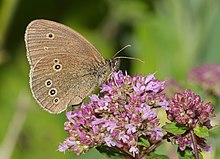Aphantopus hyperantus
| Ringlet | |
|---|---|
 |
|
 |
|
| Scientific classification | |
| Kingdom: | Animalia |
| Phylum: | Arthropoda |
| Class: | Insecta |
| Order: | Lepidoptera |
| Family: | Nymphalidae |
| Genus: | Aphantopus |
| Species: | A. hyperantus |
| Binomial name | |
|
Aphantopus hyperantus (Linnaeus, 1758) |
|
Note that information on this species applies to Western Europe and some details may not be consistent with the species in other parts of its range.
The ringlet (Aphantopus hyperantus) is a butterfly in the family Nymphalidae. It is only one of the numerous "ringlet" butterflies in the tribe Satyrini.
The ringlet is a widely distributed species found throughout much of the Palearctic realm. In Europe it is common in most countries but absent from northern Scandinavia, peninsular Italy (found in northern Italy), Portugal, southern and central Spain (found in Cantabrian Mountains and the eastern Pyrenees), the Mediterranean islands and North Africa. In Greece it is found in northern regions (Macedonia, Thessaly). Beyond Europe it is found across much of temperate Asia including Russia, Siberia, Mongolia, China and Korea.
Aphantopus hyperantus is a medium-sized butterfly with a wingspan of up to 35 to 42 millimeters. The wing upper and lower sides are solid brown with small, yellowish-rimmed eyespots. The newly emerged ringlet has a velvety appearance and is almost black with a white fringe to the wings. The number and size of the eyespots is variable, they may be missing on the upper wing surface. In central Europe and southern England the rare form arete occurs. The eggs are pale yellow when first laid, but become pale brown.
The caterpillars are about 25 millimeters long. They are gray or light reddish brown and have dark, reddish brown and very fine dots. Dorsally there is a dark longitudinal line, which is widened at the segment boundaries. Toward the rear, this line is more intensely colored. The head is darker and has several faint longitudinal stripes.
Newly emerged, with one spot
Fresh, with one spot
Worn specimen with two spots
Faded specimen with three spots
Underside
Status uncertain.
They live in grassy, moist or dry forest clearings with bushes but not in open places. There is a strong degree of attachment to woodland edges and blackberry bushes. The insect can also be very common where there are creeping thistles (Cirsium arvense) or swamp thistles (Cirsium palustre), oregano (Origanum vulgare), forest scabious (Knautia sylvatica), or hogweed (Heracleum sphondylium) which are favorite food plants of the imagos. The males fly in search of newly hatched females in slow, uninterrupted flight and flutter round, about and between grass stems.
...
Wikipedia
